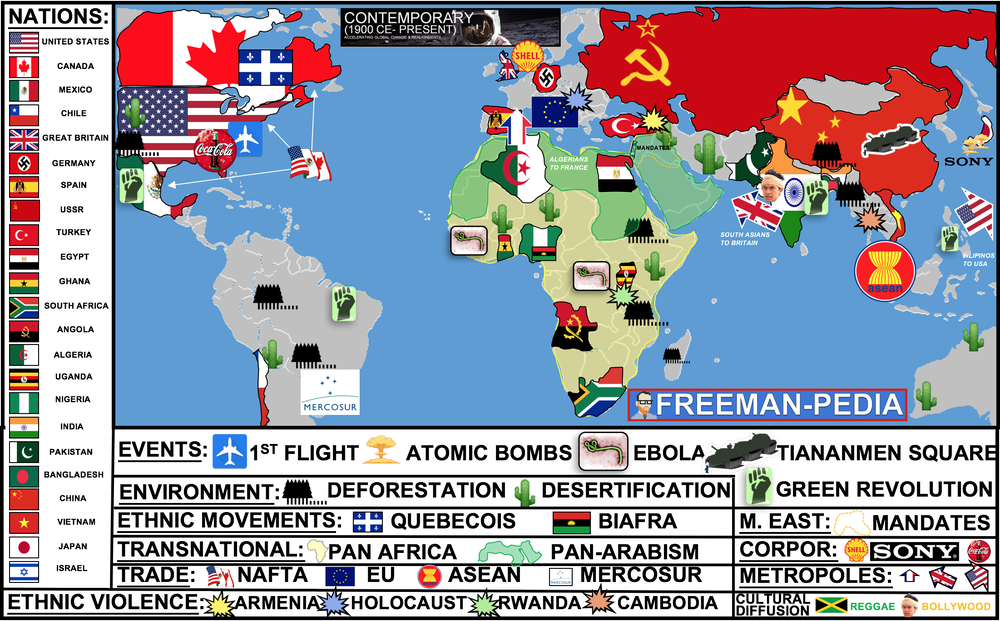8.6 Newly Independent States After 1900
3 min read•february 13, 2023
K
Katie Moore
Jillian Holbrook
K
Katie Moore
Jillian Holbrook
AP World History: Modern 🌍
577 resourcesSee Units
Israel
Since the beginning of Judaism, Jewish people were in diasporic communities-- groups of people united by ethnicity or religion that are scattered instead of centralized in one place like a state. At any rate, after the horrors of WWII, Jews began to demand their own nation. This idea of a Jewish state is called Zionism.
After previously stated European support for this idea, such as the British Balfour Declaration, the United Nations created Israel in 1948 by carving it out of Palestine. As a result, there was a lot of Jewish immigration to Israel.
As one can imagine, Palestinians (and other Arab countries) were incredibly upset by this decision. Israel and Palestine have been at war ever since, with conflicts including the Yom Kippur War and the Six-Day War.
Cambodia
Cambodia, similar to Vietnam, was originally part of French Indochina. Once World War II ended, authoritarian leaders in Cambodia grappled for power, and the resulting political chaos led to communists gaining power under the Khmer Rouge, a notoriously violent group.
During the time the Khmer Rouge was in power, they aggressively attempted to make the country agricultural again by forcefully collectivizing farms. This, accompanied by many other violent techniques, such as murdering anyone suspected of dissent, killed about 1.5 million people in the Cambodian genocide.
Pakistan
The Muslim League, a group of Muslims living in India, called for Muslim Indian separation from the newly decolonized India. Led by Muhammad Ali Jinnah, the Muslim League worried that the Hindu majority of India would always overpower Muslim interests.
After some debate, the larger state remained India, and a smaller partition became Pakistan for Muslims. While Muslims wanted to move to Pakistan, they had to cross India first. Mass migration of Muslims to Pakistan grew from messy to downright bloody, and by the time the partition of India and Pakistan was complete, two million were dead.
Economic Systems in the New States
Each new state adapted to the globalizing economy in different ways.
India
In India, Indira Gandhi demolished the private sector by nationalizing parts of the economy, such as banks, the insurance sector, and the coal industry. Investors and entrepreneurs essentially had to get governmental permission before doing anything. India represents one of the more extreme examples of governmental involvement in the economy.
Egypt
Gamal Abdel Nasser’s economic development in Egypt was a little different. The major goal during his period of control over Egypt was modernizing the nation, including the nationalization of the Suez Canal, breaking up large estates, and encouraging the growth of the middle class.
Tanzania
In Tanzania, Julius Nyerere also tried to modernize. He collectivized large farms and heavily promoted education. At his urging, Tanzania created universal education, vastly increasing literacy.
Sri Lanka
Sirimavo Bandaranaike was a Sri Lankan politician who served as the world's first female prime minister, holding the office three times between 1960 and 2000. Unlike India, she promoted free enterprise, though she did nationalize some industries. Under her leadership, the wealth gap in Sri Lanka declined immensely.
Migrations
No matter where, in this period, migrations were largely motivated by escaping economic or political crises at home. Some examples include:
- South Asians to Britain
- Filipinos to the U.S.
- Algerians to France

REVIEW GAME: True or False
- The Indian National Congress, or INC, pushed hardest for the creation of a Muslim state by the partition of India
- Zionism was the idea that Indian Muslims deserved their own state
- The communist Khmer Rouge took over Cambodia, and their violent methods caused the Cambodian Genocide
- Indira Gandhi was for little governmental involvement in the economy
- Israeli-Palestinian conflicts have been continuing ever since the creation of Israel in 1948
- Muhammad Ali Jinnah led the Muslim League
Answers:
- False: it was the Muslim League
- False: it was the idea that Jews deserved their own state
- True
- False: she essentially destroyed the private sector and heavily employed governmental control in the economy
- True
- True
Browse Study Guides By Unit
🐎Unit 1 – The Global Tapestry, 1200-1450
🐫Unit 2 – Networks of Exchange, 1200-1450
🕌Unit 3 – Land-Based Empires, 1450-1750
🍕Unit 4 – Transoceanic Interactions, 1450-1750
✊🏽Unit 5 – Revolutions, 1750-1900
🚂Unit 6 – Consequences of Industrialization, 1750-1900
💣Unit 7 – Global Conflict, 1900-Present
🥶Unit 8 – Cold War & Decolonization, 1900-Present
✈️Unit 9 – Globalization, 1900-Present
✏️Frequently Asked Questions
🚀Thematic Guides
🗺Regional Guides
🤓Historical Thinking Skills
🧐 Multiple Choice Questions (MCQ)
📋Short Answer Questions (SAQ)
📝Long Essay Questions (LEQ)
📑Document Based Questions (DBQ)

© 2023 Fiveable Inc. All rights reserved.